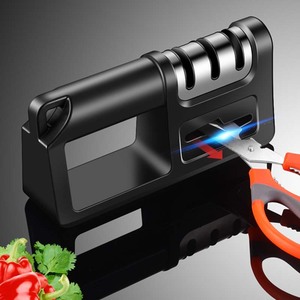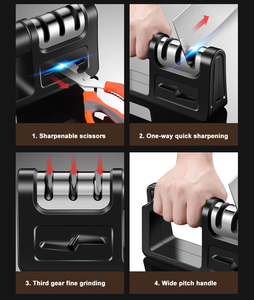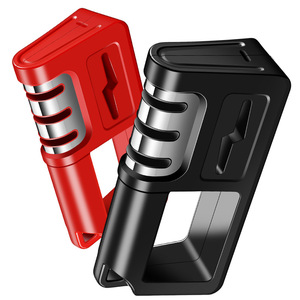(40 products available)













































































































































































































There are several types of knife Reeve, including:
Fixed Blade Knife Reeves
These knives have blades that are fixed in position and cannot be folded or retracted into the handle. They are highly durable and reliable, making them suitable for heavy-duty tasks and outdoor activities like camping and hiking.
Folding Blade Knife Reeves
The folding knives have blades that can be folded into the handle, making them compact and portable. They are convenient for everyday carry and are often used for activities like general utility, self-defense, and hiking.
Multi-Tool Knife Reeves
These are versatile knives that incorporate multiple tools into one device, such as blades, screwdrivers, scissors, and can openers. They are designed for functionality and are handy for various tasks, making them ideal for outdoor activities, camping, and emergencies.
Combat Knife Reeve
These knives are designed for military or self-defense use. They are often sleek, fast, and have features like tanto or serrated edges. These knives are designed for quick deployment and effectiveness in combat situations.
Hunting Knife Reeve
These knives are designed specifically for hunting purposes, such as skinning, field dressing, and butchering game. Typically, they have sharp blades and comfortable handles that allow precise control. They are also used for camping and other outdoor activities.
Utility Knife Reeve
Utility knives are designed for general-purpose tasks such as cutting, slicing, and trimming. They have blades that are often replaceable and ergonomic handles for comfortable use. These knives are used in industries such as construction, packaging, and carpentry.
Specifications of Knife Reeve vary depending on the type of reeve being discussed. In this case, Knife Reeve refers to a brand of knives or a specific type of knife configuration. Here are some general specifications that may apply:
Maintaining knife reeve is essential for ensuring optimal performance and longevity. Here are some general maintenance tips that may apply:
Choosing a knife reeve is a complex process that involves weighing several important variables. Here are some of them:
Purpose
When selecting a knife, its intended use should be considered first. Different knives are created for different uses, such as cooking, camping, or everyday carrying. For instance, a versatile EDC knife like the Reeve Ti-Lock may be useful for opening packages, while a chef's knife like the Reeve 25 may be useful for food preparation.
Blade Material
Consider the type of steel used in the blade's construction. Each steel has unique qualities that make it suitable for certain applications. For instance, S45VN steel is robust and provides excellent edge retention. This makes it perfect for EDC knives that need to withstand regular use.
Handle Material
Consider the material used in the knife's handle. If it is made from a comfortable and durable material, this will ensure a secure grip. Titanium and carbon fiber are popular handle materials in Reeve knives. They provide a sturdy, ergonomic grip that enhances the knife's overall performance.
Blade Size and Shape
The size and shape of the knife blade should be chosen based on the intended use. While larger blades are more effective for heavy cutting tasks, smaller blades are more portable and versatile. A blade with a drop point shape may be more useful for everyday tasks.
Locking Mechanism
For folding knives, consider the type of locking mechanism used. A reliable lock ensures the blade stays securely in place during use. Reeve knives often employ the frame lock mechanism, which is known for its strength and safety.
Portability
Consider how easy it will be to carry the knife. If a knife is to be used frequently outside the home, it should be lightweight and compact. Reeve offers a variety of knives with different sizes and weights, making it easy to find one that meets portability needs.
Legal Considerations
Before purchasing a knife, be sure to familiarize yourself with the local knife laws and regulations. Some areas have restrictions on blade length and locking mechanisms. Be sure to select a knife that complies with the applicable laws to avoid any legal issues.
Reeve knives can be easily fixed with a few tools. Here's what is needed:
Follow these steps to fix the knife:
If the blade is not aligning properly, the spacing between the blade and handle needs to be checked. Any debris or dirt affecting the spacing should be cleared. Then, the tension at the pivot point can be adjusted if needed before reassembling.
More complicated issues like a damaged handle or problems with the blade grind may require a professional knife maker or repair service to fix. But most minor problems can be handled with these steps.
Q1: What is a knife Reeve?
A1: A knife Reeve is a term used to describe knives made by renowned custom knifemaker.
Q2: Are knife Reeves good?
A2: Yes, knife Reeves are good. They are strong, durable, and reliable.
Q3: Can I get a knife Reeve on Alibaba.com?
A3: Yes, users can find knife Reeves on Alibaba.com. They should search for the desired knife Reeve and contact the supplier for inquiries.